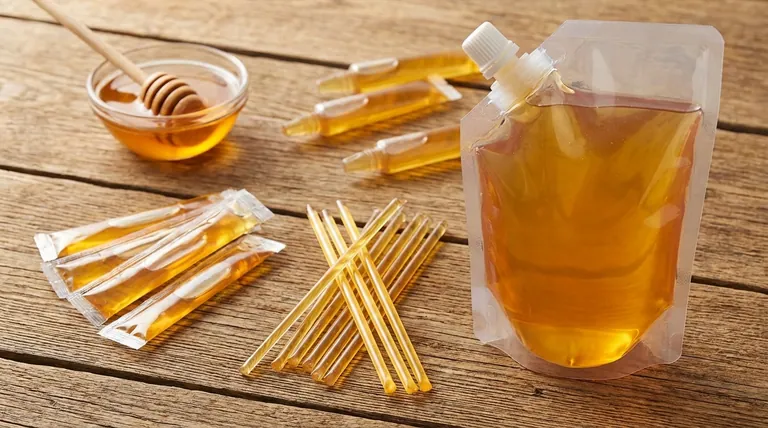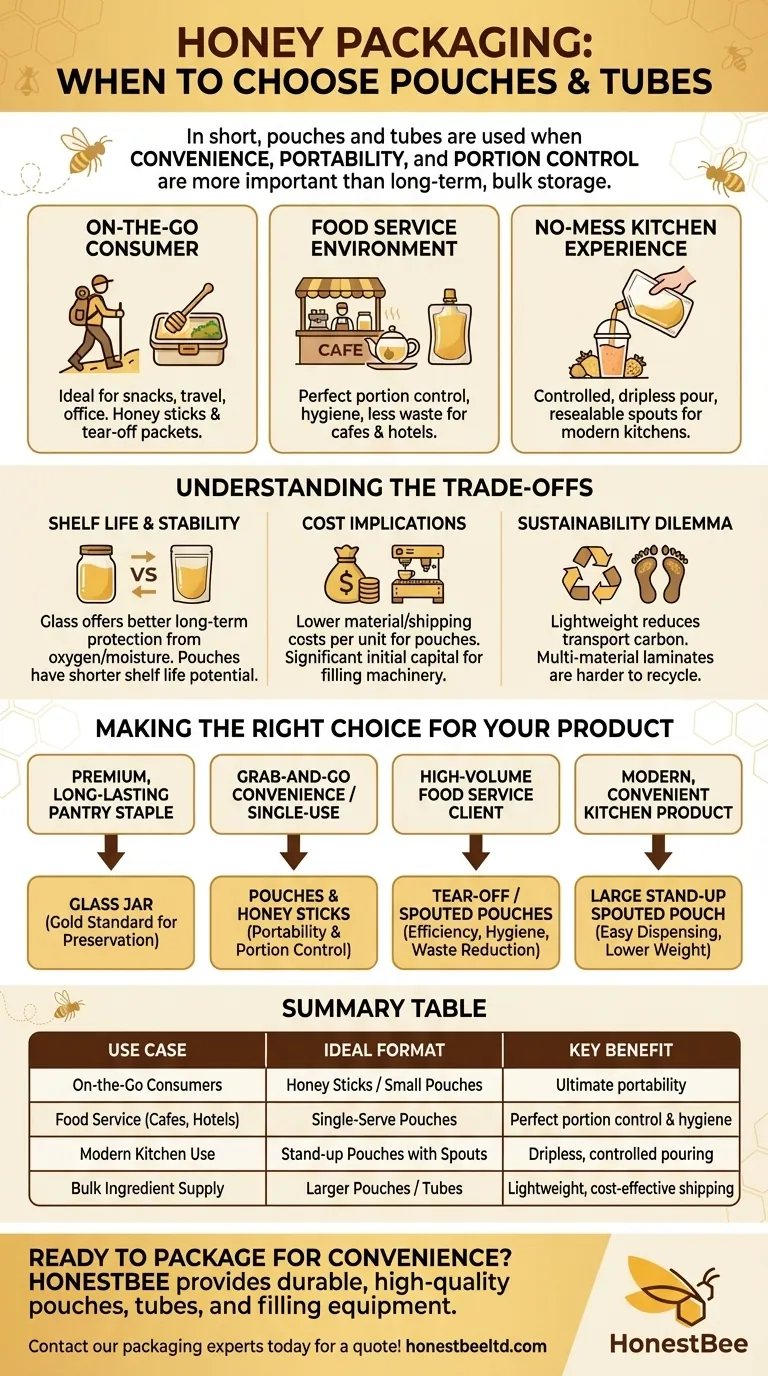In short, pouches and tubes are used for honey packaging when convenience, portability, and portion control are more important than long-term, bulk storage. These flexible formats are specifically chosen for single-serving applications, such as on-the-go snacks or pre-measured portions in a food service environment, where a traditional glass jar would be impractical.
The choice between a pouch and a traditional jar is not just about the container; it's a strategic decision about your target customer and their moment of consumption. While jars excel at preservation, pouches and tubes are engineered for a specific use case: delivering honey with maximum convenience and minimal mess.

The Primary Driver: Portability and Portion Control
The fundamental reason to choose a pouch or tube is to solve a problem for the end-user that a jar cannot. This is almost always related to convenience in a specific context.
The "On-the-Go" Consumer
Pouches are the definitive choice for consumers who need honey away from home. Formats like small, squeezable "honey sticks" or flat tear-off packets fit easily into lunch boxes, purses, or gym bags.
This format allows honey to be positioned as a portable energy snack or a convenient sweetener for drinks at the office or while traveling.
The Food Service Environment
In commercial settings like cafes, restaurants, and hotels, efficiency and hygiene are paramount. Single-serving pouches provide perfect portion control for tea service, oatmeal bars, or yogurt parfaits.
This minimizes waste, eliminates the need for shared honey pots (which can be messy and unhygienic), and streamlines operations for staff.
The No-Mess Kitchen Experience
Even for at-home use, larger stand-up pouches with resealable spouts offer a modern alternative to traditional squeeze bears or jars.
They provide the user with a controlled, dripless pour for adding honey to recipes, smoothies, or tea, avoiding the sticky residue often associated with scooping from a jar.
Understanding the Trade-offs
Flexible packaging is not a universal solution. Its benefits in convenience come with critical trade-offs in preservation, cost structure, and sustainability that must be carefully considered.
Shelf Life and Product Stability
The primary drawback noted in food science is that flexible films offer less protection than glass. Glass is virtually impermeable to oxygen and moisture.
Most pouches are made of multi-layered plastic films. While modern barrier layers (like EVOH or metallized films) are very effective, they are generally less protective over long periods than glass. This can potentially lead to a shorter shelf life or subtle changes in the honey's flavor profile and moisture content over time.
Cost Implications: Unit vs. Capital
Per unit, a pouch often uses less material and is significantly lighter than a glass jar, which can lead to lower material and shipping costs, especially at high volumes.
However, the machinery required for forming, filling, and sealing pouches represents a significant capital investment compared to the simpler equipment needed for jarring. This initial cost can be a barrier for smaller producers.
The Sustainability Dilemma
Flexible packaging presents a complex sustainability picture. On one hand, its light weight reduces the carbon footprint of transportation.
On the other hand, the multi-material laminates that give pouches their barrier properties are notoriously difficult to recycle in most municipal systems. This contrasts with glass and PET plastic, which have well-established recycling streams.
Making the Right Choice for Your Product
Your ideal packaging format depends entirely on the market you serve and your primary business goal.
- If your primary focus is a premium, long-lasting pantry staple: A glass jar remains the gold standard for conveying quality and ensuring maximum product preservation.
- If your primary focus is grab-and-go convenience or single-use servings: Pouches and honey sticks are the ideal format for portability and precise portion control.
- If your primary focus is a high-volume food service client: Tear-off or spouted pouches offer unmatched efficiency, hygiene, and waste reduction in a commercial kitchen.
- If your primary focus is a modern, convenient kitchen product: A larger stand-up pouch with a resealable spout combines the easy dispensing of a squeeze bottle with a lower packaging weight.
By aligning your packaging with your customer's specific needs, you move beyond simply containing your product to actively enhancing their experience with it.
Summary Table:
| Use Case | Ideal Format | Key Benefit |
|---|---|---|
| On-the-Go Consumers | Honey Sticks / Small Pouches | Ultimate portability for snacks & drinks |
| Food Service (Cafes, Hotels) | Single-Serve Pouches | Perfect portion control, hygiene, less waste |
| Modern Kitchen Use | Stand-up Pouches with Spouts | Dripless, controlled pouring, resealable |
| Bulk Ingredient Supply | Larger Pouches / Tubes | Lightweight, cost-effective shipping |
Ready to package your honey for convenience and efficiency?
As a leading wholesale supplier to commercial apiaries and distributors, HONESTBEE provides the durable, high-quality pouches, tubes, and filling equipment you need to meet the demands of the on-the-go and food service markets. Let us help you choose the right packaging solution to enhance your customers' experience.
Contact our packaging experts today to discuss your needs and request a quote!
Visual Guide

Related Products
- Classic Honey Bear Jars with Flip Top Dispensing Cap for Liquid Sweeteners
- Inverted Squeezable Honey Jar with No Drip Flip Top Cap for Easy Pouring
- Classic Drum Shaped Glass Honey Jar with Airtight Lid
- Precision Durable Efficient HONESTBEE Rotary Honey Filling Machine
- Modern Honeycomb Pattern Wooden Honey Dipper for Stirring and Drizzling
People Also Ask
- What packaging issues can arise from excess moisture in honey? Prevent Container Failure & Spoilage
- What is honey bear packaging, and why is it popular? Unpacking Its Marketing Power
- How should honey bottles be prepared before pouring honey into them? The #1 Rule for Honey Longevity
- How long do you let honey sit before bottling? Achieve Crystal-Clear Honey for Your Business
- How does honey get packaged? Preserve Quality and Boost Appeal



















